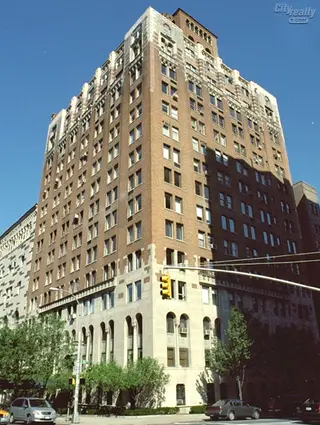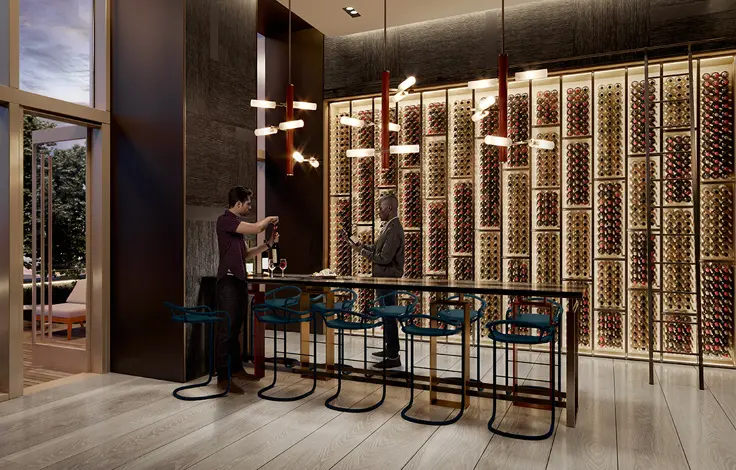 Carter Horsley
Carter HorsleyDec 23, 2011
Carter's Review
This 15-story apartment building was erected in 1929 by Arthur Brisbane, an editor with the Hearst organization who had earlier developed the Ritz Tower on the northeast corner of Park Avenue and 57th Street, designed by Emery Roth and an important early midtown skyscraper.
For this building, Brisbane commissioned Schultze & Weaver, the architectural firm that designed the Sherry Netherland Hotel and the Pierre Hotel lower down on Fifth Avenue.
This neo-Romanesque-style building was converted to a co-operative in 1978. It has 59 apartments.
Bottom Line
Arthur Brisbane, the journalist and developer, had tastes that rivaled his publisher, William Randolph Hearst and although his triplex penthouse here has long since been subdivided, this building reeks of elegant living and fine vistas even if its exterior detailing is a bit heavy-handed.
Description
The building, which is just to the north of Mt. Sinai Hospital, has a four-story limestone base with a large arched window above the attractive, canopied entrance and arched windows on the first floor that have slightly indented top corners, a subtle touch. There are arched windows also on the third floor and the top two floors.
Amenities
The building has a full-time doorman, a gym, a bicyle room, and it permits pets. The building has sidewalk landscaping.
Apartments
Penthouse A is a three-bedroom duplex unit with a 12-foot-wide entry foyer on the upper level flanked by a 21-foot-long living room with a corner fireplace, a 14-foot-long library, and a 21-foot-long master bedroom on one side and a 16-foot-long dining room and a 23-foot-long eat-in kitchen, almost all of which is surrounded by a broad, 1,900-square-foot, landscaped terrace. The lower level has a 15-foot-long den, a 9-foot-long staff room and two bedrooms.
Penthouse S is a three-bedroom unit with a small entry foyer that leads to a 16-foot-long dining room next to a 19-foot-long kitchen on one side and a 21-foot-long living room with a corner fireplace and two bedrooms on the other with a 70-foot-long south terrace, a 55-foot-long west terrace and a 33-foot-long east terrace.
Apartment 11A/12B is a four-bedroom duplex unit with three bedrooms and a large playroom on the lower level and the upper level has an entry foyer leading to a long gallery that opens onto a large living room with a fireplace adjacent to a wood-paneled 12-foot-wide library and a 27-foot-long dining next to an enclosed eat-in, 22-foot-long kitchen and a master bedroom.
Penthouse B is a one-bedroom unit with an entry into the 22-foot-long living room with a wood-burning fireplace next to a 9-foot-long study next to a large kitchen that leads to a 20-foot-long greenhouse. Four sides of the apartment have terraces.
Apartment 7AB is a four-bedroom unit with a 16-foot-long entry foyer that leads to a 28-foot-long living room with fireplace flanked by a 19-foot long library and a 22-foot-long dining room off the 12-foot-long kitchen, 12-foot-long breakfast room and a 12-foot-long maid’s room. The unit also has a 10-foot-long study, and a 12-foot-long second foyer near the 22-foot-long master bedroom.
Apartment 10C is a three-bedroom unit with an 8foot-wide entry foyer that leads to a 16-foot-long gallery that opens onto a 27-foot-long living room with a fireplace next to a 21-foot-long long dining room adjacent to a 21-foot-long kitchen with a breakfast area, a 12-foot-olng study and a 12-foot-long staff room.
Apartment 5A is a one-bedroom unit with a 13-foot-long entry foyer that leads to a 22-foot-long living room with a fireplace, a 12-foot-long enclosed dining room and a 12-foot-long kitchen.
History
Brisbane died in 1936 and three years later the building was foreclosed.
“Brisbane was the highest paid newspaperman of his day, perhaps of any day in terms of purchasing power of money. In the early 1930s William Randolph Hearst paid him two hundred fifty thousand dollars a year to write a six-day-a-week column entitled ‘Today,’ which appeared on the front page of the Hearst tabloids and hundreds of other newspapers in the United States, according to Jerry E. Patterson in his book, “Fifth Avenue, the Best Address,” (Rizzoli International Publications, Inc., 1998).
Brisbane, Patterson continued, was “astonishingly prolific” and he wrote five hundred thousand words a year; in fifty-three years of journalism, he calculated that he had written 25 million words. “Most of them might as well have been written on the wind so far are posterity was concerned. He was a master of superficiality and platitudes; his column required the minimum effort on the part of reader: no long words, no opinions that would bewilder them. Although his superficiality was complete; he was energetic; he had a dictaphone (one of the earliest) in his car and crews of secretaries and messengers to rush his copy to the office of The New York Journal, his hometown outlet.”
A bronze medallion of Brisbane is set in a Fifth Avenue wall in the building.
An August 15, 1937 article in The New York Times described Mr. Brisbane’s apartment that was put up for rent after his death:
“The apartment, occupying the three upper floors of 1,215 Fifth Avenue…, contains more than thirty large rooms, seven fireplaces and eighteen baths. One of the unusual features is a living room 60 feet long, 30 feet wide and two stories in height. There are few apartments of equal size in New York….One of the last large apartments available was that of the late John Markle, coal magnate, which consisted of forty rooms, but it had to be divided into smaller suites before being rented…..Carrere & Hastings designed the living room. A special entrance on Fifth Avenue leads to a private lobby and elevator which runs directly to the Brisbane suite…..Mr. Brisbane was said to been particularly fond of the living room. Dominating each end of that great hall is a massive sculpture fireplace on Caen Stone imported from France. Five windows, each 18 feet in height and about 6 feet wide, give broad views of Central Park. Murals high up under an elaborate Italian Renaissance ceiling depict the history of various countries in Europe. There were the work of William DeLeftwich Dodge.’”
According to a August 10, 1962 article in The New York Times, “the late Mayor Fiorella H. La Guardia had an apartment in the building from which he made many of his radio broadcasts.

- Co-op built in 1929
- 2 apartments currently for sale ($3.2M to $4.65M)
- Located in East Harlem
- 59 total apartments 59 total apartments
- 10 recent sales ($120.7K to $3.3M)
- Doorman
- Pets Allowed







 6sqft delivers the latest on real estate, architecture, and design, straight from New York City.
6sqft delivers the latest on real estate, architecture, and design, straight from New York City.
